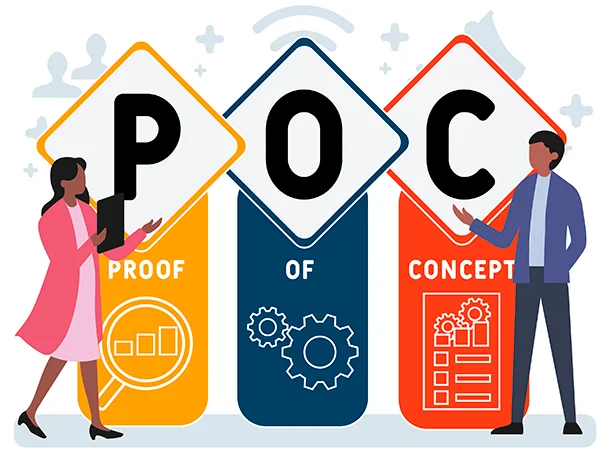Proof of Concept (PoC) will help you get a clear idea of what you’re doing before you even get started. Furthermore, proof of concept in the blockchain space is not just for exploring the market for ideas. Moreover, you won’t be able to determine the best way to start the production process. Instead, you’ll work on your possible blockchain solution option and see if it’s likely to materialize. Let’s find out with Coincu through the article below.
What is Proof of Concept (PoC) In blockchain?

In the context of cryptocurrencies and blockchain technology, Proof of Concept (PoC) refers to a demonstration or test implementation that demonstrates the practicality and functionality of a new cryptocurrency, the blockchain protocol, or a specific feature in the blockchain network. This is a preliminary stage in the development process to provide evidence that a particular concept or idea can be effectively implemented.
A PoC in cryptocurrency typically involves creating a small-scale version of a blockchain network or a specific use case for validating certain technical or functional aspects. It helps developers, researchers, and stakeholders assess the viability of a new cryptocurrency or blockchain idea before committing to development and full-scale deployment.
Blockchain PoC Development Process
Proof of Concept development goes through several stages to ensure that business requirements are understood and met. The Proof of Concept blockchain development process typically goes through the following stages:
- Definition of enterprise value
The first step of the PoC development process involves determining the business value the customer wants to demonstrate. During this process, we work with the client to test the project’s initial theoretical and practical implications to perfect it.
- Outline scope
Once the project’s business value has been determined, the scope of the PoC blockchain will be outlined. Here, the PoC begins to take shape – the stakeholders define and agree upon the project implementation. This phase also involves determining the project’s most suitable blockchain consensus mechanism.
- Engineering Architectural Design
At this stage, the primary technical architecture of the PoC is laid out. For architectural design purposes, the best technology platform and solution must also be determined. This offers the option of private, public, or hybrid blockchains in addition to permissioned and permissionless blockchains.
- PoC development
The PoC itself may be created once the architecture and solution have been established. This phase may include a lot of different sub-steps depending on how complicated the proof of concept is. For instance, at this point, UI and administration may need to be created, APIs may need to be built, and so forth.
- PoC Introduction and Analysis
The PoC is presented to the customer and examined following the development process. This phase shows that the blockchain project concept is both feasible and workable. Depending on how the project turns out, this can result in the creation of an MVP before a full-fledged blockchain application is created.
What are the benefits of PoC?
Putting Proof of Concept into practice brings significant benefits to stakeholders:
- Technology Validation: PoC validates the technical feasibility of a cryptocurrency or blockchain solution. It demonstrates that the underlying technology works as intended and can achieve its goals.
- Functional demonstration: PoC introduces core functions of cryptocurrency or blockchain feature. For example, it can demonstrate how a new consensus algorithm, smart contract, or security mechanism works in a controlled environment.
- Performance Evaluation: PoC helps to evaluate the performance of the proposed solution. This can include transaction speed, scalability, security, and energy efficiency.
- Use Case Testing: PoC focuses on a specific use case or application scenario to demonstrate how cryptocurrency or blockchain technology can solve real-world problems or provide value treatment.
- Risk Mitigation: By conducting a PoC, the potential risks and challenges associated with the development and implementation of a cryptocurrency or blockchain solution can be identified early, allowing for adjustments and improvements.
- Stakeholder Engagement: A successful PoC can attract interest and investment from stakeholders, including potential investors, developers, and users, by demonstrating the practical benefits of the proposed blockchain or cryptocurrency concept.
It is important to note that Proof of Concept is a first step and does not necessarily guarantee the full implementation or adoption of a cryptocurrency or blockchain solution. If PoC proves successful, further development, testing, and fine-tuning are often required to build a complete and robust product that can be scaled.
Application of PoC in Blockchain
Proof of Concept (PoC) plays a vital role in developing and implementing blockchain technology. It helps demonstrate blockchain solutions’ feasibility and potential value before committing to full development and implementation. Here are some common uses of PoC in the blockchain context:
- Supply Chain Management: PoC can be used to showcase how blockchain can improve transparency and traceability in the supply chain. PoC can demonstrate how goods can be tracked at each stage of the supply chain, ensuring authenticity and reducing fraud.
- Identity Management: PoC can explore how blockchain can enhance identity verification and management. This could involve creating a prototype for an autonomous identity system where individuals control their personal data.
- Financial Services: PoC can be used to test new financial products and services using blockchain technology. For instance, a PoC could show how cross-border payments can be settled faster and with reduced fees using a blockchain-based system.
- Smart Contracts: PoCs can demonstrate the functionality and benefits of smart contracts, which are self-executing contracts with the terms of the agreement written directly into the code.
- IoT and Supply Chain Integration: PoC can show how blockchain can enhance the integration of Internet of Things (IoT) devices in the supply chain, enabling seamless tracking and management of goods.
- Digital Identity and Authentication: PoC can explore how blockchain can provide secure and tamper-proof authentication for digital identities, reducing the risk of fraud and unauthorized access.
- Energy Management: PoC could showcase how blockchain can facilitate peer-to-peer energy trading, allowing individuals and institutions to buy and sell surplus energy directly.
- Healthcare: Blockchain PoC can illustrate how patient records can be securely stored and accessed between healthcare providers, ensuring their integrity and privacy.
- Voting System: PoC can be used to test blockchain-based voting systems that enhance transparency and tamper resistance in elections.
- Real Estate: Blockchain PoC can demonstrate how asset transactions and ownership records can be managed more efficiently and securely.
In all of these cases, a well-executed Proof of Concept helps stakeholders understand the potential benefits, limitations, and challenges of implementing blockchain solutions. It provides a tangible demonstration of how technology can solve real-world problems and encourages further investment and development.
Conclusion
The blockchain proof of concept will quickly help you to know if your company is ready for a significant investment in blockchain. So you’ll save money by not betting everything on just one idea. In addition, the implementation of PoC will help you have a basis and basis to argue with investors or stakeholders about your theory or hypothesis, which will be a valuable help to your arguments and arguments about the feasibility of the idea.
However, there can be many reasons for a PoC blockchain to fail, such as flawed user demand, inadequate timing, insufficient workforce, etc. But whatever the outcome, a proof of concept blockchain is always needed for businesses.
DISCLAIMER: The information on this website is provided as general market commentary and does not constitute investment advice. We encourage you to do your own research before investing.





